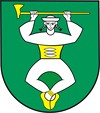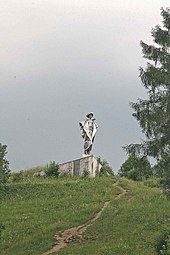Terchová
| Terchová | ||
|---|---|---|
| coat of arms | map | |

|
|
|
| Basic data | ||
| State : | Slovakia | |
| Kraj : | Žilinský kraj | |
| Okres : | Žilina | |
| Region : | Severné Považie | |
| Area : | 84.542 km² | |
| Residents : | 4,076 (Dec. 31, 2019) | |
| Population density : | 48 inhabitants per km² | |
| Height : | 514 m nm | |
| Postal code : | 013 06 | |
| Telephone code : | 0 41 | |
| Geographic location : | 49 ° 15 ' N , 19 ° 2' E | |
| License plate : | ZA | |
| Kód obce : | 518042 | |
| structure | ||
| Community type : | local community | |
| Structure of the municipality: | 2 parts of the community | |
| Administration (as of November 2018) | ||
| Mayor : | Jozef Dávidík | |
| Address: | Obecný úrad Terchová Sv. Cyrila a Metoda 96 013 06 Terchová |
|
| Website: | www.terchova.sk | |
| Statistics information on statistics.sk | ||
Terchová ( Hungarian Terhely - until 1902 Tyerhova ) is a municipality with 4076 inhabitants (as of December 31, 2019) in northwestern Slovakia near the regional capital Žilina .
geography
The community extends in the so-called furrow of Terchová (Slovak Terchovská brázda ), which belongs to the valley basin Žilinská kotlina (German about Silleiner basin ). To the north of the furrow is the Kysucká vrchovina mountain range , while the Krivánska Fatra , a sub-mountain range of the Little Fatra, rises to the south . In Terchová , the river Varínka, coming from the Vrátna Valley ( Vrátna dolina in Slovak ), bends towards the west and receives streams flowing from the north and east. Not least because of this location, Terchová is one of the major tourist resorts of the Little Fatra. Important mountains of the Little Fatra such as the Veľký Rozsutec ( 1610 m nm ) and the Veľký Kriváň ( 1709 m nm ) are located in the municipality. The community center is located at an altitude of 514 m nm and is 25 kilometers east of Žilina . The distance to the capital Bratislava is 225 kilometers (road distance).
In addition to the actual place Terchová and the village Horná Tižina , which was incorporated in 1991 , the municipality consists of numerous small settlements / hamlets (Slovak Mz. Kopanice ) in a similar form as in the nearby region of Kysuce . According to the municipality, there are a total of 68 settlements in the municipality, better known of which are Jánošikovci northeast of the main town and the touristic Štefanová in the Vrátna valley.
Neighboring municipalities of Terchová are Nová Bystrica in the north, Zázrivá in the east, Párnica in the southeast, Šútovo and Turany in the south, Belá in the west and Lutiše in the north-west.
history
Two finds come from the time BC: a bronze ax discovered in 2010, dated to the time of 1500 BC. Chr. ( Lausitz culture ), and an iron spearhead from the time of the Puchau culture .
The first written mention is dated April 22, 1580 and is related to the colonization of the area under Wallachian law . A document from 1598 recorded the place name as Králowa alias Tyerchowa ; in the same year there were 19 houses and a mill in the village. At first the village belonged to the Gbeľany and Strečno rulers, and in the 17th century it came into the hands of the Teplička Manor . With this change of ownership came new settlers who previously settled as Wallachians in the mountains of Teschen and Kysuce in the 16th century.
Until 1731 Terchová had neither a parish nor a church; the nearest church was in Varín, 15 kilometers away . In the same year a church was built and dedicated to the patronage of St. Dedicated to Martin of Tours. In 1784 the community had 381 families and 2,164 inhabitants, in 1828 there were 425 houses and 3,427 inhabitants who were employed as shepherds, quarry and forest workers. In the 19th century there were ten mills and a paper mill in Terchová. At the same time, many residents emigrated because of poor soil and plague epidemics.
Until 1918 the place in Trenčín County belonged to the Kingdom of Hungary and then came to Czechoslovakia or now Slovakia. In the final days of the Second World War , on April 7th and 8th 1945, Terchová was set on fire by the retreating German troops, killing 170 houses. As part of a two-year plan, the place was rebuilt by 1947, at the same time 96 families left Terchová for southern Slovakia. A brick factory worked until 1945 and a quarry until 1967.
population
According to the 2011 census, Terchová had 4021 inhabitants, 3969 Slovaks , 13 Czechs , three Magyars and one German , one Croat , one Moravian , one from Rome , one Russian and one Ukrainian . Four residents indicated a different ethnic group and 26 residents gave no information about the ethnic group .
3830 residents supported the Roman Catholic Church , nine residents the Greek Catholic Church , seven residents each for the Old Catholic Church and the Evangelical Church AB , four residents for the Pentecostal Movement, three residents for the Orthodox Church and one resident each for the Jehovah's Witnesses to Evangelical Methodist Church and the Reformed Church; 10 residents professed a different denomination. 55 inhabitants were without a denomination and the denomination of 78 inhabitants has not been determined.
politics
coat of arms
Blazon : "In green, a silver man looking forward in the same wide-sleeved clothing with hat and pigtails in a jump, feet crossed, with golden boots and a girdle of the same kind, holding a golden ax with both hands over his head."
Declaration of the coat of arms: The dancing man in the coat of arms in local shepherd's clothing, which includes the ax, represents the Slovak national hero, freedom fighter and robber chief Juraj Jánošík , who was born and grew up in Terchová.
Monuments and culture
In the center of Terchová is the Roman Catholic Cyril and Methodist Church from 1949, which replaced the then dilapidated St. Martin's Church. Inside the church there is a wooden nativity scene . On a small hill above Terchová there has been a larger than life (7.5 meters) stainless steel statue since 1988 (on the occasion of the 300th birthday) as a memorial to Juraj Jánošik, the work of the sculptor Ján Kulich . There is also a Juraj Jánošík Museum in the house where he was born.
Terchová is also known as the center of Slovak folk culture and folklore. Since 1962, the folklore festival Jánošíkove dni (literally Jánošík's days) has been held every year in July and August , where folk culture, customs and handicrafts are presented. Furthermore Terchová venue of the liturgical festivals Cyrilskometodské dni (literally Cyril and Methodius Day) and on country music -oriented event Country Festival Rozmarín and rock music -Veranstaltung Terchovský Budzogáň .
An important part of folk culture is the music of Terchová ( Terchovská muzika in Slovak ). Oral transmission through generations yielded both vocal and instrumental forms of music. The string ensemble consists of three to five members who play violins, double bass, two-string bass or accordion, often accompanied by polyphonic singing and folk dances. Solo play by shepherds on the beaked flute is also one of the traditional forms. Since 2013, the music of Terchová has an entry in the UNESCO - List of Intangible Cultural Heritage of Humanity .
traffic
The 2nd order road 583 (short II / 583) passes through Terchová, which starts in Žilina and continues over the Rovná hora saddle ( 751 m nm ) towards Párnica and Dolný Kubín . Local roads connect the scattered hamlets and the Vrátna valley.
The nearest train station with international connections is Žilina Train Station , 25 kilometers away. Local trains also stop at Varín station, 16 kilometers away on the Žilina – Košice railway line . There are several daily bus connections from / to Žilina and other surrounding places.
Personalities
- Juraj Jánošík (1688–1713), Slovak national hero and robber
- Adam František Kollár (1718–1783), writer and court librarian
- Koloman Kolomi Geraldini (1908–1994), poet, literary critic and translator
- Róbert Boženík (* 1999), football player
Individual evidence
- ↑ Informácie o obci , terchova.sk, accessed on May 1, 2016 (Slovak)
- ↑ Results of the 2011 census (Slovak)
- ↑ Juraj Jánošík Monument (Terchová) - Slovakia.travel. Retrieved February 4, 2018 .
- ^ Jánošík days - Slovakia.travel. Retrieved February 4, 2018 .
- ↑ Music of Terchová - intangible heritage - Culture Sector - UNESCO , unesco.org, accessed on May 1, 2016 (English)
Web links
- Entry on e-obce.sk (Slovak)






